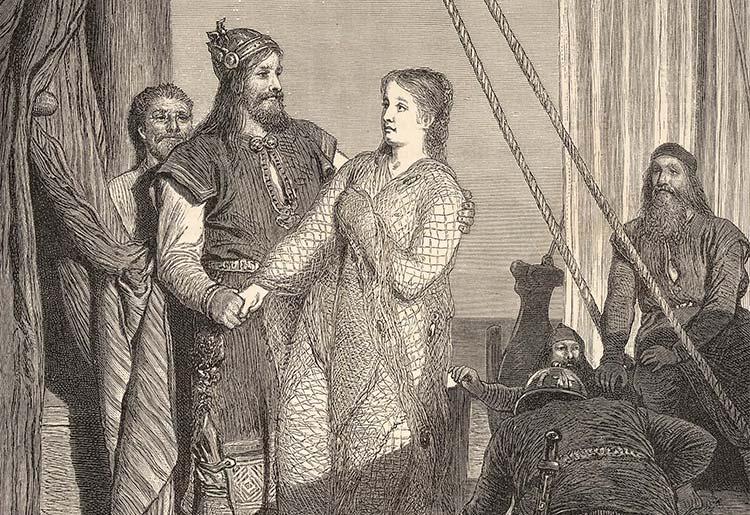
The word Viking means “pirate raid” in Old Norse, and the age of the Vikings (between 700-1100 AD) is indeed famed for its warriors’ bloodthirsty aggression. Arguably the most famous Viking warrior was the semi-legendary sea king, Ragnar Lothbrok (Ragnarr Loðbrók in Old Norse), who supposedly led raids along England’s coast.
Ambiguity pervades much of what is thought to be known about Ragnar Lothbrok. Many, if not all, of his adventures are mythical, with Lothbrok’s life largely passing into legend in medieval European literature created long after his death through the ‘Icelandic sagas’. These were based on real people and events, yet also somewhat embellished and partly made up. Lothbrok’s many 9th century raids on Francia, Anglo-Saxon England and Ireland earned him a prominent role in them.
So what is actually known about Ragnar Lothbrok, and how can we separate historical fact from fiction?
1. There is debate around his existence…
Legends claim Lothbrok was the son of a Swedish King (Sigurd Hring) and a Norwegian princess. However, the Vikings didn’t keep a written record of their history at the time. Many of the Icelandic sagas were written several centuries after Ragnar Lothbrok’s time – causing debate and doubt amongst historians over his true existence.
Some argue that stories of Lothbrok may well have been based on a variety of historical figures that were tied together into one hero, built on the reputation of the Ragnar.
It’s likely the Icelandic Sagas likely contain some truth regarding his life, but whilst it can be difficult to determine fact from fiction in these stories, some instances of fantasy are more obvious than others – such as tales of Lothbrok strangling a bear to death or fighting a giant snake, sometimes depicted as a dragon.
2. …though there is some evidence that he did exist
Whilst the evidence is scarce, with only a few references of Ragnar Lothbrok that exist in literature from the time, crucially it does exist.
The main source telling of Lothbrok’s life and heroic deeds in the Icelandic sagas is the 13th-century Icelandic ‘The Saga of Ragnar Lothbrok’. (Other sagas mentioning him include Heimskringla, Sögubrot, Tale of Ragnar’s Sons, and Hervarar Saga). This form of story-telling started orally, before stories were eventually written down to preserve and spread the tales.

Ragnar Lodbrok with sons Ivar and Ubba, 15th-century miniature
Image Credit: Public Domain, via Wikimedia Commons
Interestingly, Lothbrok is also mentioned in the Danish document Gesta Danorum, which contains historical information (referring to his marriages to Lagertha and Thora) as well as legends – compiled by the historian Saxo Grammaticus. Unlike the Icelandic sagas, the Gesta Danorum is known to be a fairly accurate geographic breakdown of Viking rule.
One of the most significant pieces of evidence mentioning Lothbrok as a real historical figure is from The Anglo-Saxon Chronicle, a 9th century English document, also generally thought reliable. There are two references to a particularly eminent Viking raider in 840 AD, ‘Ragnall’ and ‘Reginherus’ – both considered to be Lothbrok.
The fact that other historical documents outside Viking culture at this time also mention Lothbrok by name serves to corroborate his existence and activity – to an extent.
 Listen Now
Listen Now3. He had at least 3 wives
It is generally agreed Lothbrok married at least three women.
His first wife, Lagertha, was a Nordic shield maiden who fought with Lothbrok as warriors in Norway when he was avenging the death of his grandfather, Fro. Despite once allegedly attacking him with a hound and bear that guarded her home, she eventually became Lothbrok’s wife.
Viking legend says that Lothbrok had to slay a giant snake to win his second wife, Thora.
His third wife, Aslaug, was said to be the daughter of legendary dragon slayer, Sigurd, and the shieldmaiden, Brynhildr. Lothbrok asked her a riddle during their courtship, and proposed to her soon after, charmed by her clever response.
The tales of Ragnar’s wives may well have been the result of an attempt to combine three separate legends. Danish history includes mention of a possible fourth wife, Swanloga.
4. His nickname was ‘Hairy Breeches’ or ‘Shaggy Breeches’
This derives from Lothbrok allegedly boiling his cow-hide trousers in tar which he claimed protected him from the snake (or dragon, according to some sources) whilst winning his second wife Thora’s hand in marriage.
5. He had several sons – many of whom have been verified as genuine historical figures
While the fantastic stories about Lothbrok can be hard to verify, there is evidence to prove that his sons might have been real historical figures. Significantly more evidence exists about their authenticity than Lothbrok himself, with many living in the same places and times as the references made about them. The sons claimed to be Lothbrok’s direct offspring, giving further historical context to Lodthbrok himself.

King Ella’s messengers before Ragnar Lodbrok’s sons
Image Credit: August Malmström, Public domain, via Wikimedia Commons
Indeed a Viking warrior called Bjorn – probably Bjorn Ironside, a skillful naval commander – is known to have raided the area around Paris in 857-59. Additionally, Ivar the Boneless and Ubbe were among the leaders of the ‘Great Heathen Army’. (Ivar is recorded as having died in Dublin in 873, and Ubbe to have been killed in battle in Devon in 878).
Along with Halfdan Ragnarsson, all are genuine figures. Historical accounts from conquered peoples verify their existence and activity.
A reference to Bjorn Ironside by Norman historian William of Jumièges in 1070 also named a Danish king, ‘Lothbrok’ as Bjorn’s father. A few years later, chronicler Adam of Bremen referenced Ivar, ‘cruellest of Norse warriors’, as another of Lothbrok’s sons. Nevertheless, we don’t know for certain whether these references were about the same Ragnar Lothbrok.
The first reference to record the names Ragnar and ‘Lothbrok’ together was Icelandic scholar Ari Þorgilsson, writing between 1120-1133, claiming that ‘Ivar, son of Ragnar Lothbrok’ had been the one to kill Edmund of East Anglia.
Other Vikings claiming to be sons of Lothbrok included Hvitserk, Fridleif, Halfdan Ragnarsson and Sigurd Snake-In-The-Eye. It’s hard to know whether these historical figures were related to Lothbrok by blood, especially as at the time, warriors often claimed lineage to legendary figures to enhance their own status. Viking men also sometimes adopted younger men to appoint as their successors. Lothbrok himself claimed to be a direct descendant of Odin.
6. He tended to favour ‘blitzkrieg’-style tactics
Like other Vikings, several sources note how Lothbrok used blitzkrieg-like tactics. These terrorised, demoralised and overwhelmed his opponents before they could gather a strong-enough force to oppose him. He also only fought when the odds were in his favour.
7. He is said to have laid Seige to Paris
A Danish Viking leader, Reginheri, is one figure that Lothbrok might be based on. Reginheri is said to have raided the coasts of France, culminating in an attack and seige of Paris in 845. ‘Charles the Bald’ had assembled his army into 2 parts on either side of the River Seine. Lothbrok therefore simply attacked the smaller army, wiping it out in full view of their other comrades.
The French didn’t wish to deal with another conflict as they had more important worries to contend with, so Charles the Bald reportedly paid Ragnar’s fleets off with 7,000 livres of silver (around 2.5 tons).
However, Frankish chronicles report that Lothbrok was defeated, with him and his men dying from disease, though Danish records state that he went on to pillage the Irish coast and began a settlement near Dublin, until his death in the mid-850s.
8. He was used as a form of propaganda
Some literature of the time was written as political propaganda – by exaggerating the threat Lothbrok posed, it made any victory against him seem more impressive. Later, the sagas stated that the mere mention of Ragnar Lothbrok’s name could spread fear among his enemies.

The legendary king Ragnar Lodbrok, relief in Frederiksborg Castle, Hillerød, Denmark
Image Credit: Orf3us, CC BY-SA 3.0
Once dead and his abilities no longer a threat, tales of Lothbrok’s mighty fighting prowess grew even stronger, further mythologising his deeds and inadvertantly adding ambiguity to the line between fact and fiction.
9. There are debates over the manner of his death
According to Danish historian Saxo Grammaticus’ Gesta Danorum, after several raids in the north-west of England, Ragnar was eventually captured by Anglo-Saxon King Ælla of Northumbria and thrown into a snake pit to die. During his death, Lothbrok is quoted as saying “How the little piglets would grunt if they knew how the old boar suffers” – foretelling the revenge his sons would reek. He is also said to have recalled previous victories and looked forward to the prospect of entering a great feasting hall for slain Viking warriors after his death, the Valhalla.
Although this story is also recounted in the later Icelandic works (Ragnars saga loðbrókar and Þáttr af Ragnarssonum), other historians believe Ragnar Lothbrok died sometime between 852-856 during a storm on one of his voyages along the Irish Sea whilst pillaging the coasts of Ireland.
10. His ‘sons’ left a lasting impact on Britain
Lothbrok’s death became an incentive to rouse many of his sons to align and establish a unified front with other Norse warriors against England. This ‘Great Heathen Army’ (of approximately 4,000 men – at a time when armies usually numbered mere hundreds) landed in England in 865 where they killed Edmund the Martyr and later King Ælla, marking the start of Viking occupation in parts of England.
 Listen Now
Listen Now













